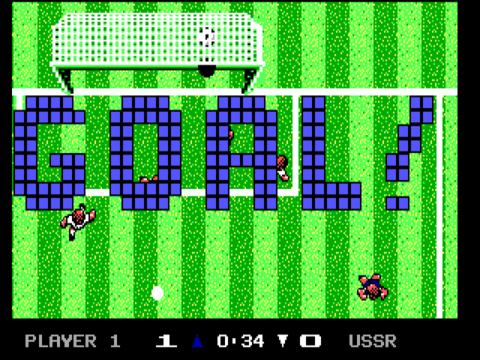
Microprose Soccer
Written by: Rik
Date posted: March 24, 2024
- Genre: Sport
- Developed by: Sensible Software/Designer Software
- Published by: Microprose
- Year released: 1989
- Our score: 4
English football in the late 80s had little in common with the glamorous, professional product of the modern Premier League era, and was in those days a sport played largely by heavy-drinking men on muddy pitches in front of dwindling crowds housed in crumbling stadiums. In the gaming world, with the exception of those products in receipt of a celebrity endorsement, it was a time of generic players depicted in hand-drawn box art which attempted to conjure mental images of on-pitch excitement that were rarely matched by the action contained within.
Your correspondent’s memories, repeated in this ancient and inadequate feature, are of Jon Ritman’s Match Day II being the game of choice for home computer users of the time, before the baton was passed, briefly, to Emlyn Hughes International Soccer, until the Kick Offs and Sensible Soccers of this world took over. This slightly sketchy genealogy, however, completely overlooks the existence of Microprose Soccer, Sensible Software’s original attempt at creating an arcade football title, which first introduced the fast-paced, top-down gameplay that would capture the public imagination on 16-bit formats a few years later.
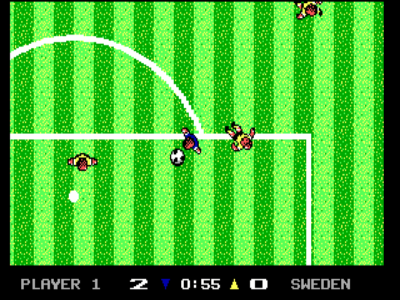
Slide all you want, Swedish defender, for you are no match for the mighty Player 1 from the famous gaming site A Force for Good!
And, with mild guilt at having once translated a historical preference for Kick Off 2 into a sneery piece dismissing the merits of what many consider to be the greatest football game of all time driving several subsequent attempts over the years to say something nice about Sensible Soccer in the interests of balance, the opportunity to dig up this ancient relic in the interests of giving credit where it’s due proved too much to resist. [As if you need an excuse to play an old football game – Ed.]
Having said that, upon firing up the game, the folly of choosing the PC as the battleground for re-litigating fake footballing debates from this particular period soon presents itself, as the ears are immediately assaulted by anxiety-inducing speaker music which, it turns out, cannot be turned off completely. This DOS version is a port of Sensible’s Commodore 64 original, which also comes bundled with the commercially available release (more on which later), and serves as a reminder of an era when the PC was among the least palatable platforms for a multi-format title.
(Whenever Retro Gamer magazine does a feature on one of those arcade games that spanned all of the major home computer formats, the summaries of the merits of different versions – Spectrum: Plays ok, no colours; C64: Plays ok, some muted colours; ST: Looks ok in stills, but not as smooth as the Amiga version; DOS: Absolute dogshit, why would you ever play this? – are often the same).
Still, despite making a less than promising first impression (compounded by the need to be very precise when calibrating the joystick controls), out on the pitch, a semi-playable game remains intact. The action is more zoomed in than in Sensible Soccer, and with the ball sticking to your player’s feet and passing a risky endeavour, it’s largely a case of dribbling as far as possible with whichever player has the ball and booting a shot at goal from a suitable angle. A diagonal effort from the edge of the box is pretty reliable, although some success is also possible from a straighter position by making use of the so-called ‘Banana Shot’ – i.e. curling the ball after striking it, later known as ‘After Touch’ in Kick Off 2 – and flummoxing the opposition goalkeeper.
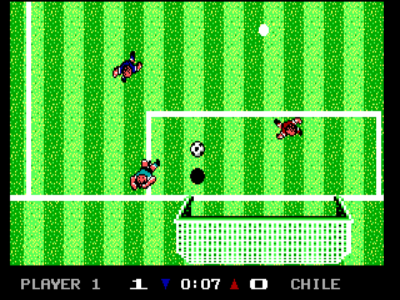
Scoring with seconds to spare. If the timer reaches zero, however, regardless of whether the ball is on its way into the goal, the ref will – like Clive Thomas in the 1978 World Cup – blow his whistle and end play.
Sadly, your own goalkeeper is even more inept, mainly because he is you, with control passing from defender to ‘keeper in an instant too brief for anyone of advancing age to make the necessary mental adjustments, with your goalie in all likelihood sent rushing out of goal in the wrong direction by your erroneous instructions, leaving the AI to punt the ball into the unguarded net. (My own puzzle about why each opposition goal is preceded by a comedy ‘brrp’ noise akin to a car skidding on an oil slick in an arcade racer of a similar vintage was answered by the manual telling me this sound indicates the transfer of control from outfield player to goalkeeper, rather than being part of an in-built system of mockery).
Otherwise, your defensive game revolves around making judicious (and occasionally injudicious) use of the slide tackle. There are no fouls, free kicks or penalties, although when the pitch is wet your players may wobble around on their arses for a few seconds more after sliding, which acts as the only real disincentive to repeatedly launching yourself at the opposition in an attempt to win back possession.
Assuming your interest in playing old football games from the 80s does not extend to members of your household, neighbours or evening dinner guests, then the options for the solo player are limited to a couple of tournaments. The Microprose International Challenge is a series of games against increasingly more skilled opponents, whom you must beat to progress: draw, and you must play them again; lose, and you’re back to the previous opponent (or you can, of course, re-load a save); while a full World Cup, following the traditional mini-league-then-knockout format, can also be attempted. There is the additional option to play a 6-a-side, indoor version of the game, too, with walls surrounding the pitch, rush goalies, and American opponents (presumably in recognition of the long-defunct Major Indoor Soccer League).
While the ruthlessness of the opposition, able to rack up significant numbers of goals even within the confines of a 2-minute match, if you’re being particularly unlucky/inept, is initially off-putting, with practice, some progress can be made. Although the absence of fairly basic fundamentals of football like fouls and free kicks may seem a bit jarring, such omissions arguably help the action along and keep things simple.
There are some subtleties, too, like being able to tap the button to dribble the ball ahead of you and make speedier progress up the pitch, while the essential *fistpump* YES! feeling of scoring a goal is definitely present and correct, especially in tight matches where it comes off the back of some desperate/lucky defensive efforts. (Constructive use of the overhead kick feature, however, sadly eluded me).
The goals definitely seem to flow more easily than in the C64 version, with the 8-bit original representing – and these things are relative – a slightly more considered affair than this port. The emulated version also looks and sounds better, and doesn’t have the same control calibration issues to contend with (your diagonals will go wrong if you aren’t careful in this one), although the retail GOG release I downloaded gave me no option to play outdoors and even mild tinkering with the emulator failed to produce a positive result, leaving me little option but to find an alternative way of accessing the game on C64. (If you’re going to monetise these ancient titles, making it all accessible with a couple of clicks is a must, really. Also, even allowing for manuals and emulators, quite why the GOG download is 300MB, I’m not really sure).
The DOS version is still perfectly ok, though. In some respects – the larger player sprites, the easier control over the ball – it’s preferable to Sensible Soccer, although it’s missing too many other features and – particularly – teams and tournaments to really make a case for itself as the superior game, even to a Sensi cynic.
The one really big downer is those player-controlled goalkeepers, which got on my nerves in the same way as abandoned review candidate World Championship Soccer, although not to the same extent or with the same impact on my results. (In fact, I did wonder whether there was some link between the two games, perhaps via arcade title Tekhan World Cup, said to be the main influence on Microprose Soccer, but there isn’t – although Sensible did later produce (under a pseudonym) a sequel to World Championship Soccer on the Megadrive).
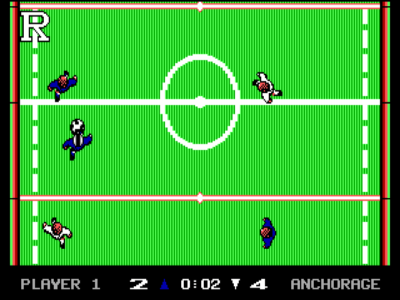
Taking control of the goalkeeper is even more hairy in the indoor league, as he can leave the area, and even try to score a goal himself.
It’s interesting to see how Sensible started off, and the evolution of their approach between this game and their most successful series. Arguably, it has more in common with Kick Off than with Sensible Soccer, and while there might be an argument for saying that they took things in the wrong direction, the massive commercial and critical success they subsequently enjoyed suggests I’m in the minority.
While Microprose Soccer might not quite have me singing its praises from the rooftops, or entreating everyone to buy and play it, for an EGA football title from 1989, it holds up pretty well, and there’s enough here to keep the dedicated retro football fan occupied for a few hours at least.

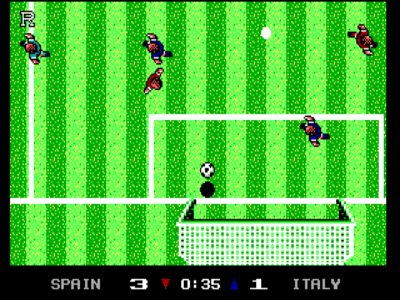

 Posts
Posts